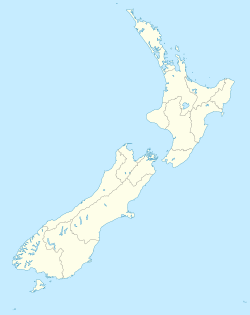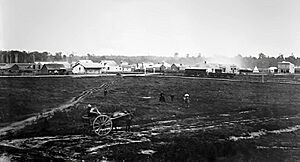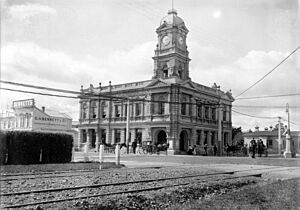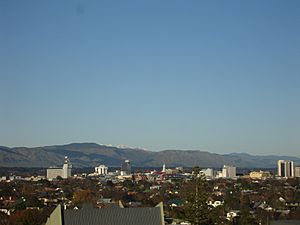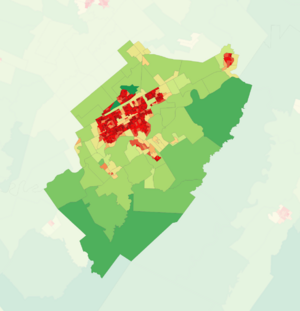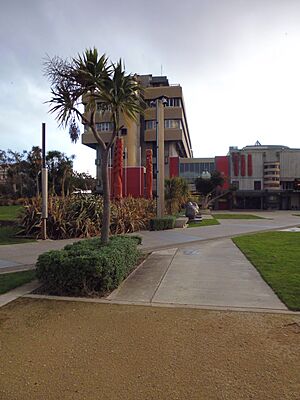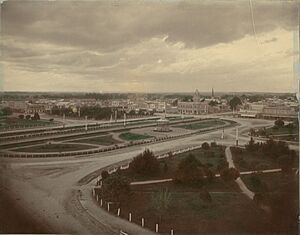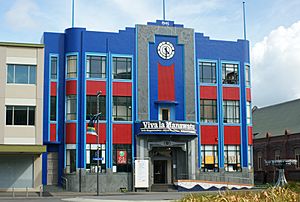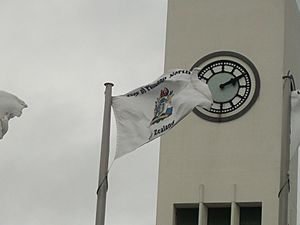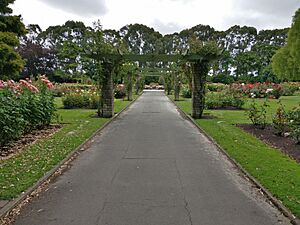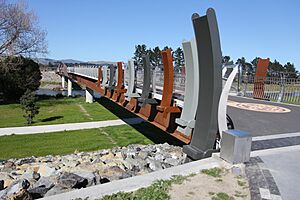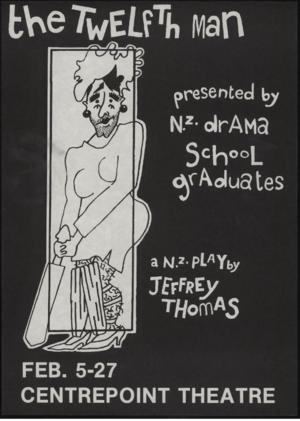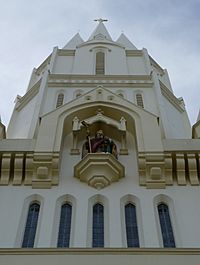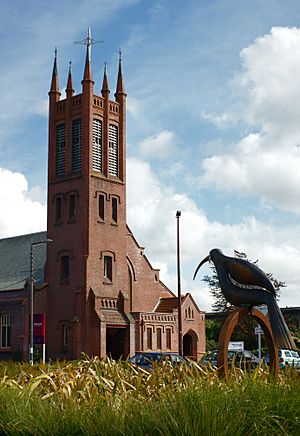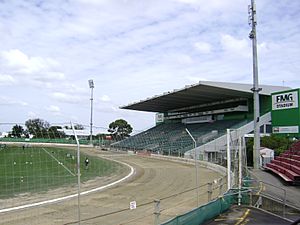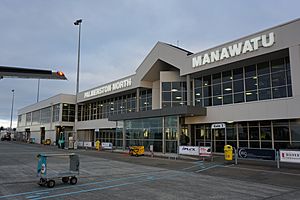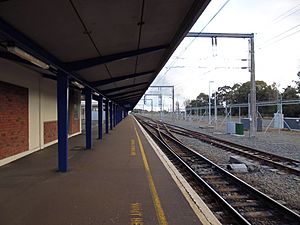Palmerston North facts for kids
Quick facts for kids
Palmerston North
Te Papaioea (Māori)
|
||
|---|---|---|
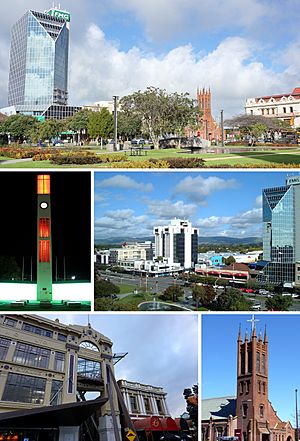
Clockwise from top: The Square, Central Business District, All Saints Church, City Library, The Square Clock Tower
|
||
|
||
| Nickname(s):
Palmy
|
||
| Motto(s):
Palmam Qui Meruit Ferat
(Let him who has earned it, bear the reward) |
||
| Country | New Zealand | |
| Island | North Island | |
| Region | Manawatū-Whanganui | |
| Borough proclaimed | 1877 | |
| City proclaimed | 1930 | |
| Electorates | Palmerston North, Rangitīkei; (Māori): Te Tai Hauāuru | |
| Area | ||
| • Territorial | 394.74 km2 (152.41 sq mi) | |
| • Urban | 77.05 km2 (29.75 sq mi) | |
| Highest elevation | 760 m (2,490 ft) | |
| Lowest elevation | 10 m (30 ft) | |
| Population
(June 2023)
|
||
| • Territorial | 91,800 | |
| • Density | 232.56/km2 (602.3/sq mi) | |
| • Urban | 82,500 | |
| • Urban density | 1,070.7/km2 (2,773.2/sq mi) | |
| • Demonym | Palmerstonian | |
| Time zone | UTC+12 (NZST) | |
| • Summer (DST) | UTC+13 (NZDT) | |
| Post codes |
4410, 4412, 4414, 4471, 4472, 4475, 4810, 4820
|
|
| Area code(s) | 06 | |
| Local iwi | Ngāti Rangitāne | |
Palmerston North is a lively city in the North Island of New Zealand. People often call it Palmy for short. It's the main city in the Manawatū-Whanganui region.
The city sits on the eastern Manawatu Plains, close to the Manawatū River. It's about 140 kilometres (87 miles) north of Wellington, New Zealand's capital. Palmerston North is the eighth-largest urban area in New Zealand.
The city's official area includes some rural parts. These areas stretch towards the Tararua Ranges. They also include small towns like Ashhurst, Bunnythorpe, and Longburn. The city covers about 395 square kilometres (153 square miles).
Long ago, this area was a forest clearing. Small groups of Māori lived here. They called it Papa-i-Oea, which means "How beautiful it is." In the mid-1800s, European settlers arrived. They were mainly from Scandinavia and Britain.
The British named the settlement Palmerston. This was to honour Viscount Palmerston, a former British Prime Minister. In 1871, "North" was added to the name. This was to avoid confusion with Palmerston in the South Island.
Early Palmerston North grew thanks to public works and sawmilling. The railway arrived in 1886, connecting it to Wellington. This helped the farming industry grow. Later, places like Linton Military Camp, Palmerston North Hospital, and Massey University (started in 1927) brought more skilled jobs.
Today, popular spots include Te Manawa. This is a museum and art gallery that also has the New Zealand Rugby Museum. There are also many places for plays and music.
Contents
- Exploring Palmerston North's Past
- Understanding Palmerston North's Geography
- Who Lives in Palmerston North?
- How Palmerston North is Governed
- Palmerston North's Economy and Jobs
- Fun Things to Do in Palmerston North
- Sports in Palmerston North
- Getting Around Palmerston North
- Learning in Palmerston North
- Media and Communication
- Sister Cities
- Famous People from Palmerston North
- Things Named After the City
- See also
Exploring Palmerston North's Past
How Palmerston North Began
The local Māori people, Ngāti Rangitāne, lived in this area. They called it Te Ahu-ā-Tūranga. Around 1830, a trader named Jack Duff was the first European to explore here. He shared his discovery, and others became interested.
In 1846, another trader, Charles Hartley, heard about a clearing in the Papaioea forest. He found this clearing, which was perfect for a town.
In 1858, the government started buying land from the Māori in Manawatu. After some discussions, the Rangitāne people sold the Te Ahu-a-Turanga Block in 1864. This opened the area for more settlers.
In 1866, John Tiffin Stewart surveyed the Papaioea clearing. He designed the town with wide, straight streets and a large open space. This space is now known as The Square. The settlement was named Palmerston.
The first settlers included people from Scandinavia in 1871. Later that year, "North" was added to the name. This was to tell it apart from another town called Palmerston in Otago.
The railway line was built through The Square in 1875. By this time, Palmerston North had newspapers, a doctor, and a post office. The original All Saints Church also had its foundation stone laid in 1875.
Growing into a City
By 1877, Palmerston North was a small, isolated village. Its population was 880 by 1878. Sawmilling was the main business.
The railway arrived in 1886, helping the town grow faster. It became a centre for farming. The Longburn Freezing Works opened, providing jobs. The council also started building important things like a sewerage system. The railway to Napier was finished in 1891.
In 1893, more land became available for settlement. The Public Hospital opened in a wooden building. By 1900, the population reached 6,000.
Palmerston North continued to grow steadily. By 1911, the population was about 10,991. During World War I, the Awapuni Racecourse was used as an army training camp. After the war, celebrations were delayed because of the Influenza epidemic.
Becoming a City and Beyond
In 1930, Palmerston North's population reached 20,000. It was officially named a city, the 7th in New Zealand. Growth slowed during the Great Depression and World War II.
An airport was built at Milson in 1936. This is now Palmerston North Airport. From 1938, the government started building state houses.
In 1941, the Manawatū River flooded. Large parts of Hokowhitu and Awapuni went underwater. Residents had to move to higher ground.
During World War II, the Māori Battalion was formed and trained in Palmerston North. Linton Military Camp was also set up in 1942. After the war, the city grew quickly.
In 1959, the railway line was moved. Trains no longer went through The Square. The new railway station opened in 1963. The last trains passed through The Square in 1964.
In 1963, Massey Agricultural College joined with Palmerston North University College. This formed Massey University College of Manawatu. In 1964, it became Massey University, which could grant its own degrees.
In 1969, volunteers created the Esplanade Scenic Railway. This miniature railway offers rides through native bush. In 1970, the New Zealand Rugby Museum was established.
In 1977, Palmerston North City Council celebrated 100 years of local government. The Queen and the Duke of Edinburgh visited the city.
In 1989, Palmerston North's city boundaries grew. They included areas like Ashhurst, Linton, and Turitea. In 2012, Bunnythorpe and Longburn also became part of the city.
Understanding Palmerston North's Geography
Palmerston North is surrounded by the Ruahine and Tararua mountain ranges. However, the city itself is mostly flat. The land rises a bit further from the river, especially in the north and south.
Most of the city is between 20 and 40 metres (65–130 feet) above sea level. The highest point in the city is 760 metres (2,493 feet) high. This is in the Tararua ranges. The lowest point is 10 metres (33 feet) above sea level, by the Manawatū River.
The city has 5.54 square kilometres (1,369 acres) of public reserves. The Manawatū River flows for 29.9 kilometres (18.6 miles) within the city limits. Its tributary, the Pohangina River, runs for 2.6 kilometres (1.6 miles) near Ashhurst.
What's the Weather Like?
Palmerston North has a mild climate. Summers are warm, with temperatures around 20–22°C (68–72°F). Winters are cooler, around 12°C (54°F). Temperatures go above 25°C (77°F) about 20 days a year.
The city gets about 960 millimetres (38 inches) of rain each year. It rains about 5% of the time. On average, there are 200 days without rain each year.
The ranges near the city often have strong winds, especially in spring. These ranges are known for having some of the most consistent wind in New Zealand. This is why there are many wind farms here. These wind farms have 286 turbines. They provide power for about 50,000 homes.
| Climate data for Palmerston North (1991–2020 normals, extremes 1928–present) | |||||||||||||
|---|---|---|---|---|---|---|---|---|---|---|---|---|---|
| Month | Jan | Feb | Mar | Apr | May | Jun | Jul | Aug | Sep | Oct | Nov | Dec | Year |
| Record high °C (°F) | 32.5 (90.5) |
33.0 (91.4) |
31.3 (88.3) |
28.4 (83.1) |
25.6 (78.1) |
20.9 (69.6) |
19.6 (67.3) |
22.8 (73.0) |
22.4 (72.3) |
26.2 (79.2) |
28.7 (83.7) |
31.7 (89.1) |
33.0 (91.4) |
| Mean maximum °C (°F) | 28.3 (82.9) |
28.0 (82.4) |
26.9 (80.4) |
23.6 (74.5) |
20.8 (69.4) |
17.9 (64.2) |
16.7 (62.1) |
17.5 (63.5) |
19.6 (67.3) |
21.3 (70.3) |
24.1 (75.4) |
26.3 (79.3) |
29.3 (84.7) |
| Mean daily maximum °C (°F) | 22.6 (72.7) |
23.2 (73.8) |
21.6 (70.9) |
18.7 (65.7) |
16.0 (60.8) |
13.5 (56.3) |
12.9 (55.2) |
13.8 (56.8) |
15.1 (59.2) |
16.5 (61.7) |
18.3 (64.9) |
20.9 (69.6) |
17.8 (64.0) |
| Daily mean °C (°F) | 17.9 (64.2) |
18.4 (65.1) |
16.7 (62.1) |
14.0 (57.2) |
11.7 (53.1) |
9.4 (48.9) |
8.8 (47.8) |
9.5 (49.1) |
11.0 (51.8) |
12.5 (54.5) |
14.0 (57.2) |
16.5 (61.7) |
13.4 (56.1) |
| Mean daily minimum °C (°F) | 13.1 (55.6) |
13.6 (56.5) |
11.7 (53.1) |
9.2 (48.6) |
7.3 (45.1) |
5.2 (41.4) |
4.7 (40.5) |
5.2 (41.4) |
6.8 (44.2) |
8.4 (47.1) |
9.7 (49.5) |
12.1 (53.8) |
8.9 (48.0) |
| Mean minimum °C (°F) | 5.8 (42.4) |
7.1 (44.8) |
4.5 (40.1) |
1.8 (35.2) |
−0.6 (30.9) |
−1.6 (29.1) |
−2.0 (28.4) |
−1.1 (30.0) |
−0.4 (31.3) |
0.8 (33.4) |
2.7 (36.9) |
5.7 (42.3) |
−2.8 (27.0) |
| Record low °C (°F) | 0.5 (32.9) |
0.0 (32.0) |
−1.5 (29.3) |
−3.6 (25.5) |
−3.9 (25.0) |
−6.9 (19.6) |
−6.7 (19.9) |
−6.0 (21.2) |
−3.9 (25.0) |
−3.6 (25.5) |
−2.1 (28.2) |
0.0 (32.0) |
−6.9 (19.6) |
| Average rainfall mm (inches) | 58.7 (2.31) |
68.6 (2.70) |
57.4 (2.26) |
83.6 (3.29) |
87.2 (3.43) |
95.5 (3.76) |
87.5 (3.44) |
83.5 (3.29) |
89.0 (3.50) |
96.3 (3.79) |
86.3 (3.40) |
89.9 (3.54) |
983.5 (38.71) |
| Average rainy days (≥ 1.0 mm) | 8.2 | 6.8 | 7.3 | 9.1 | 10.4 | 12.0 | 11.6 | 12.7 | 11.8 | 12.4 | 9.9 | 10.2 | 122.4 |
| Average relative humidity (%) | 77.2 | 78.1 | 80.7 | 80.9 | 85.7 | 87.8 | 87.4 | 84.9 | 78.9 | 80.5 | 77.2 | 76.6 | 81.3 |
| Mean monthly sunshine hours | 207.3 | 186.5 | 184.1 | 146.3 | 116.0 | 91.3 | 110.9 | 126.1 | 130.4 | 139.1 | 163.4 | 170.3 | 1,771.7 |
| Mean daily daylight hours | 14.7 | 13.6 | 12.3 | 11.0 | 9.9 | 9.3 | 9.6 | 10.6 | 11.8 | 13.2 | 14.4 | 15.0 | 12.1 |
| Percent possible sunshine | 45 | 49 | 48 | 44 | 38 | 33 | 37 | 38 | 37 | 34 | 38 | 37 | 40 |
| Source 1: NIWA Climate Data | |||||||||||||
| Source 2: Weather Spark | |||||||||||||
Who Lives in Palmerston North?
City Population and Diversity
Palmerston North City covers about 394.74 square kilometres (152.41 square miles). In 2023, its estimated population was 87,090 people. This includes 78,021 people in the main urban area. It also includes people in smaller towns like Ashhurst.
| Nationality | Population (2018) |
|---|---|
| England | 2,748 |
| India | 1,539 |
| China | 1,440 |
| Australia | 1,155 |
| South Africa | 903 |
| Philippines | 693 |
| Fiji | 528 |
| United States | 468 |
| Samoa | 441 |
| Malaysia | 390 |
The population grew by 2.9% between 2018 and 2023. The median age in 2023 was 35.7 years. About 19.4% of people were under 15 years old.
People in Palmerston North come from many different backgrounds. In 2023, about 73.8% identified as European (Pākehā). About 20.7% were Māori. Other groups included Asian (14.4%) and Pasifika (5.9%).
English is spoken by most people (95.7%). Māori language is spoken by 5.0%. Many other languages are also spoken. About 21.8% of people were born outside New Zealand.
When it comes to religion, 31.9% identified as Christian. About 52.8% said they had no religion. Other religions like Hinduism and Islam are also present.
Many people in Palmerston North have higher education. About 19.7% of people aged 15 or older had a bachelor's degree or higher. The median income was $40,800. Most adults (51.1%) were employed full-time.
How Palmerston North is Governed
Palmerston North City Council's Role
Palmerston North is run by a city council. This council includes the Mayor and 15 councillors. They are elected by people across the whole city.
In 2017, the Council decided to create a Māori ward. This would give Māori people their own representatives. However, this decision was changed by a city-wide vote in 2018.
In 2021, the Council decided again to set up Māori and general wards. Since 2022, there is a Te Pūao Ward for Māori. It has two councillors. The Te Hirawanui Ward is for everyone else and has 13 councillors.
Before 2016, councillors were elected from five different city areas. But these areas were removed in 2013. The 2013 election also started using a new voting system called single transferable vote (STV). This replaced the older "first past the post" system.
| Name | Affiliation (if any) | Notes |
|---|---|---|
| Grant Smith | Independent | Mayor of Palmerston North |
| Debi Marshall-Lobb | Independent | Deputy Mayor |
| Brent Barrett | Green Party | Councillor |
| Roly Fitzgerald | Independent | Councillor |
| Rachel Bowen | Independent | Councillor |
| Mark Arnott | Independent | Councillor |
| Vaughan Dennison | Independent | Councillor |
| Kaydee Zabelin | Green Party | Councillor |
| Lew Findlay | Independent | Councillor |
| Pat Handcock | Independent | Councillor |
| Leonie Hapeta | Independent | Councillor |
| Lorna Johnson | Labour Party | Councillor |
| Billy Meehan | Independent | Councillor |
| Orphée Mickalad | Independent | Councillor |
| Karen Naylor | Independent | Councillor |
| William Wood | Independent | Councillor |
The council's work is divided into six main parts. These include planning, customer service, and managing money. The Chief Executive is Waid Crockett.
Regional and Central Government
Palmerston North is also the main office for the Horizons Regional Council. This council looks after the wider Manawatū-Whanganui region. Palmerston North City has four councillors representing it on this regional council.
For national elections, Palmerston North is part of two general electorates. These are the Palmerston North electorate and the Rangitīkei electorate. It's also part of the Te Tai Hauaūru Māori electorate.
Justice System in the City
The Palmerston North Courthouse handles legal matters for the city and nearby areas. It is home to both the District Court and the High Court.
Palmerston North's Economy and Jobs
Palmerston North is an important place for jobs in New Zealand. Even though it has only 1.9% of the country's population, 2.5% of all New Zealand employees work here. Key job areas include education, research, and government (like the Defence Force).
In 2013, the biggest job sectors were healthcare, education, retail, public administration, and manufacturing. The education sector brings in a lot of money for the city. It also employs many people.
Palmerston North is strong in research, especially in bio-industry. It's also important for defence and business. The city has over 70 major education and research places. These include Massey University, Universal College of Learning (UCOL), and Linton Army Camp.
Local Business Success Stories
Palmerston North has a history of new and successful businesses. One famous example is GSK (GlaxoSmithKline). Glaxo started in Bunnythorpe, which is now part of Palmerston North.
Many companies have their main New Zealand offices in Palmerston North. These include Toyota New Zealand, Higgins Group, and FMG Insurance. Other companies like Plumbing World and Steelfort Engineering are also based here.
EziBuy, a well-known clothing and homeware retailer, started in Palmerston North in 1978. It grew to be very large before being sold.
Fun Things to Do in Palmerston North
Palmerston North has many places to visit and enjoy. It's also a good starting point for exploring nearby attractions. These include Tongariro National Park and the Ruahine and Tararua Ranges.
Shopping and Downtown Areas
The Plaza Shopping Centre is the biggest mall in the Manawatū-Whanganui region. It has over 100 stores. It started as the PDC Plaza in 1986. It was updated and made bigger between 2008 and 2010.
Downtown on Broadway offers more shops and a cinema.
The Heart of the City: The Square
The Square is a large, seven-hectare park in the city centre. It has lawns, trees, lakes, and gardens. It's the city's oldest park and the starting point for the main streets.
The Square has a war memorial and a memorial for Te Peeti Te Aweawe. He was a Māori chief who helped sell the land for Palmerston North.
The Hopwood Clock Tower stands near the middle of the park. The city's information centre, the City Council building, and the City Library are also here. Shops and restaurants line the road around the park.
Around 1878, Māori leaders chose a Māori name for The Square. They called it Te Marae o Hine. This means "The Courtyard of the Daughter of Peace." It showed their hope for peace among all people.
Parks and Recreation
Palmerston North has about 100 parks and reserves.
Victoria Esplanade is a famous park. It's 26 hectares (64 acres) and sits along the Manawatū River. It opened in 1897 to celebrate Queen Victoria's 60th Jubilee. It has native bush, gardens, playgrounds, and a cafe.
Inside the Esplanade, you'll find the Peter Black Conservatory. This is a large tropical greenhouse. The Wildbase Recovery centre helps sick wildlife. The Esplanade Scenic Railway offers miniature train rides.
The Dugald McKenzie Rose Garden is New Zealand's largest rose garden. It's 1.7 hectares (4.2 acres) and hosts international rose trials. It was named one of the best rose gardens in the world in 2003.
Nearby are Ongley and Manawaroa Parks for sports. Fitzherbert Park is the main cricket ground. Other parks are used for rugby and football. The Hokowhitu Lagoon is popular for kayaking.
The Lido Aquatic Centre is the city's biggest swimming complex. Freyberg Community Pool is an indoor pool open all year. Memorial Park has a splash pad, pool, playground, and duck pond.
Riverbank Improvements
Since 2012, the city council has been improving the Manawatū River banks. They are turning neglected areas into parks. Part of this is He Ara Kotahi, a 7.1-kilometre (4.4-mile) path for walking and cycling.
This path connects the city to Massey University and Linton Military Camp. It includes a 194-metre (636-foot) pedestrian bridge. This bridge connects the Holiday Park to the path across the river. He Ara Kotahi helps people walk or cycle safely to Massey University.
Libraries and Youth Space
Palmerston North has a main public library and five smaller branches. The central Palmerston North Library is in The Square. Branches are in Ashhurst, Awapuni, Linton, Roslyn, and Te Pātikitiki. There is also a mobile library.
The Youth Space opened in 2011 near The Square. It's a safe place for young people to meet. It offers table tennis, gaming consoles, musical instruments, and books. It's free for everyone.
Arts and Culture Scene
Visual Arts
Te Manawa is the city's cultural museum. It covers art, science, and history. The New Zealand Rugby Museum is also connected to Te Manawa. There are many smaller art galleries too.
Many famous New Zealand artists have lived or worked in Palmerston North. These include Rita Angus and Shane Cotton.
Performing Arts
Palmerston North has several theatres for music and plays.
- The Regent on Broadway Theatre is a large venue with 1393 seats.
- Centrepoint Theatre is a professional theatre. It's the only one outside New Zealand's main cities.
- The Globe Theatre is a smaller community theatre. It opened in 1982. It was updated in 2014 with a second stage.
Many top comedians and performers come from Palmerston North. These include John Clarke and Shane Cortese.
Music Scene
Palmerston North has a lively music scene. Many local and national music acts perform here.
Local groups include the Manawatu Sinfonia and Manawatu Youth Orchestra. The Palmerston North Brass Band was started in 1868 by army troops. It's even older than the city itself!
Religious Places
Palmerston North is a cathedral city. The Cathedral of the Holy Spirit, Palmerston North is the main church for the Roman Catholic Diocese of Palmerston North. Bishop John Adams leads the diocese.
The city also has many other churches. These include Anglican, Baptist, Methodist, and Presbyterian churches. There are also Sikh gurdwaras and Islamic centres.
Sports in Palmerston North
Sports are very popular in Palmerston North. Many sports teams represent the wider Manawatu region.
Arena Manawatu is the main multi-sports venue. Its main stadium is home to the Manawatu Turbos rugby team. It also hosts the Robertson Holden International Speedway. There are indoor areas for netball, basketball, and badminton.
Other important sports venues include Memorial Park and Fitzherbert Park.
| Club | Sport | League | Venue |
|---|---|---|---|
| Manawatu Turbos | Rugby union | Bunnings NPC | CET Arena |
| Manawatu Cyclones | Rugby union | Farah Palmer Cup | CET Arena |
| Hurricanes | Rugby union | Super Rugby | CET Arena # |
| Central Pulse | Netball | ANZ Championship | Fly Palmy Arena |
| Central Districts | Cricket | Plunket Shield, Ford Trophy, T20 | Fitzherbert Park# |
| Manawatu Jets | Basketball | NBL | Fly Palmy Arena |
- # : not based in Manawatu, however, home ground when playing in Manawatu.
Getting Around Palmerston North
Palmerston North is an important place for roads and railways. Many freight companies have their distribution centres here.
Road Travel
Palmerston North's main roads are set up in a grid. Four main roads spread out from The Square. These are Rangitikei Street, Fitzherbert Avenue, and Main Street East and West.
State Highways
Four state highways serve Palmerston North:
 State Highway 3 connects Palmerston North to Sanson and Woodville.
State Highway 3 connects Palmerston North to Sanson and Woodville. State Highway 57 links the city to Levin and Ashhurst.
State Highway 57 links the city to Levin and Ashhurst. State Highway 56 connects to Shannon and Awapuni.
State Highway 56 connects to Shannon and Awapuni. State Highway 54 runs from Hunterville through Feilding to Newbury.
State Highway 54 runs from Hunterville through Feilding to Newbury.
Cycling Around the City
Palmerston North is considered good for cycling. The Manawatu River Pathway is a great track for families. It's mostly flat and runs for over 9 kilometres (5.6 miles). There are plans to extend it even further.
The city has 65 kilometres (40 miles) of on-road bicycle lanes. All local buses have bike racks. Tertiary students can ride buses for free.
Bus Services
Palmerston North decided to use a motorbus system in 1920. The first buses arrived in late 1921.
Today, Horizons Regional Council coordinates urban bus services. They are run by Tranzit Group. Buses run every 15-20 minutes during busy times. They run every 30 minutes off-peak and on weekends.
Palmerston North is the first city in New Zealand to have an all-electric bus fleet since February 2024. Tertiary students can ride buses for free. This is paid for by parking fees at the universities.
The city has 11 bus routes that connect different suburbs to the city centre. There is also a route to Ashhurst. Bus services also connect Palmerston North to other towns like Whanganui, Feilding, Foxton, Levin, and Marton.
Long-distance bus services are run by Intercity and Tranzit. They connect Palmerston North to Wellington, Auckland, Rotorua, Taupō, Napier, and Masterton.
Air Travel
Palmerston North Airport is in Milson, about 5.5 kilometres (3.4 miles) north of the city centre. It's a regional airport for the central North Island.
The airport has regular flights to Auckland, Christchurch, Hamilton, and Nelson. These are operated by Air New Zealand and Originair. From 1996 to 2008, there were also international flights.
You can get to the airport by bus. Two bus routes connect the airport to the city centre in about 20 minutes. The airport is also the base for the Massey University School of Aviation.
Train Services
Palmerston North is on the North Island Main Trunk Railway. There are two passenger trains. The Capital Connection is a weekday commuter train to Wellington. The Northern Explorer travels between Auckland and Wellington.
Until 1964, the railway line went through the city centre. The Palmerston North railway station was in The Square. The line was moved north between 1959 and 1963.
Near the current railway station, the North Island Main Trunk connects to the Palmerston North - Gisborne Line. This line goes through the Manawatū Gorge to Woodville and Hawke's Bay.
Learning in Palmerston North
Palmerston North is known as "the student city" in New Zealand's North Island. It has many important places for higher education. The main campuses of Massey University, Universal College of Learning (UCOL), and Institute of the Pacific United (IPU) are here. Many students live in Palmerston North.
- Tertiary Education Institutions
| School Name | Location |
|---|---|
| Massey University | Turitea |
| Universal College of Learning | Palmerston North Central |
| Institute of the Pacific United | Aokautere |
| Te Wānanga o Aotearoa | Various locations around Palmerston North |
| The Design School | The Square Palmerston North |
- Primary and Secondary Schools
Palmerston North has five state secondary schools. These are Palmerston North Boys' High School, Queen Elizabeth College, Freyberg High School, Palmerston North Girls High School, and Awatapu College.
There is also one state-integrated Catholic secondary school, St Peter's College. Cornerstone Christian School, Palmerston North is another special character secondary school.
Media and Communication
The main daily newspaper in Palmerston North is the Manawatu Standard. The Guardian is a weekly community newspaper.
Most radio stations are part of national networks. Some have studios in Palmerston North. Local stations include More FM and The Breeze. Radio Control is a local student radio station. Access Manawatu 999AM is a community station, and Kia Ora FM is a local Māori station.
The city's main television and FM radio transmitter is on Wharite Peak. This is about 20 kilometres (12 miles) northeast of the city. The first transmitter there started in 1963.
Sister Cities
Palmerston North has four sister cities around the world:
- Missoula, Montana, United States
- Guiyang, People's Republic of China
- Kunshan, People's Republic of China
- Mihara, Hiroshima, Japan
Famous People from Palmerston North
Many well-known people come from Palmerston North. Here are a few:
- John Clarke (1948–2017), a famous satirist and actor.
- Shane Cortese (born 1968), an actor and singer.
- Brendon Hartley (born 1989), a racing car driver.
- Spankie Jackzon (born 1984), a drag performer who won RuPaul's Drag Race Down Under.
- Joseph Nathan (1835–1912), who started the company Glaxo.
- Grant Robertson (born 1971), a former New Zealand politician and Deputy Prime Minister.
- David Seymour (born 1983), a New Zealand politician and leader of the ACT party.
- Ross Taylor (born 1984), a famous New Zealand cricket player.
Things Named After the City
- An NAC Vickers Viscount airplane (ZK-NAI) was called "City of Palmerston North".
- Two Ansett New Zealand de Havilland Canada Dash 8s were also named "City of Palmerston North". One of these, ZK-NEY, crashed in 1995.
See also
 In Spanish: Palmerston North para niños
In Spanish: Palmerston North para niños



